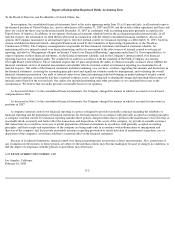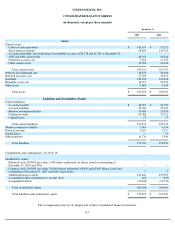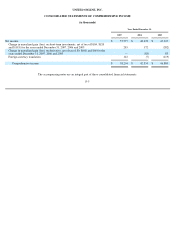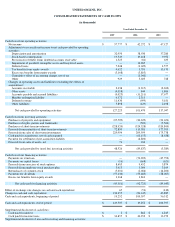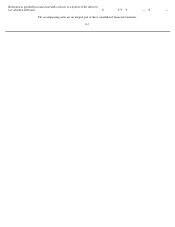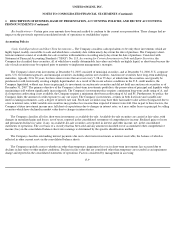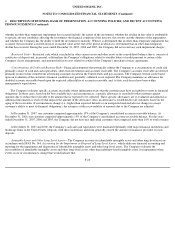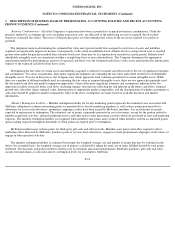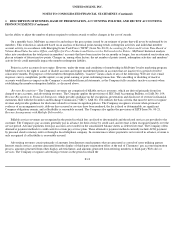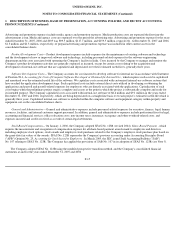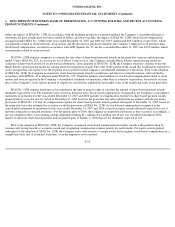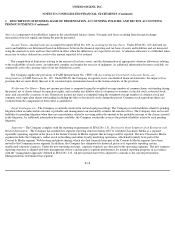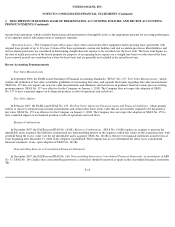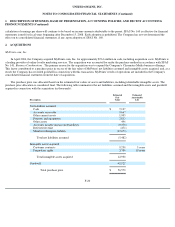Classmates.com 2007 Annual Report Download - page 93
Download and view the complete annual report
Please find page 93 of the 2007 Classmates.com annual report below. You can navigate through the pages in the report by either clicking on the pages listed below, or by using the keyword search tool below to find specific information within the annual report.
UNITED ONLINE, INC.
NOTES TO CONSOLIDATED FINANCIAL STATEMENTS (Continued)
1. DESCRIPTION OF BUSINESS, BASIS OF PRESENTATION, ACCOUNTING POLICIES, AND RECENT ACCOUNTING
PRONOUNCEMENTS (Continued)
the carrying amount of an asset may not be recoverable. Events or circumstances that may indicate that an asset is impaired include, but are not
limited to, significant decreases in the market value of an asset, significant underperformance relative to expected historical or projected future
operating results, a change in the extent or manner in which an asset is used, significant declines in the Company's stock price for a sustained
period, shifts in technology, loss of key management or other personnel, significant negative industry or economic trends, and changes in the
Company's operating model or strategy and competitive forces. In determining if an impairment exists, the Company estimates the undiscounted
cash flows to be generated from the use and ultimate disposition of these assets. If an impairment is indicated based on a comparison of the
assets' carrying values and the undiscounted cash flows, the impairment loss is measured as the amount by which the carrying amount of the
assets exceeds the fair market value of the assets. Definite-lived intangible assets are amortized on either a straight-line basis or an accelerated
basis over their estimated useful lives, ranging from two to ten years. The Company's identifiable intangible assets were acquired primarily in
connection with business combinations. The Company has no indefinite-lived intangible assets at December 31, 2007.
Property and Equipment— Property and equipment are stated at historical cost less accumulated depreciation and amortization.
Depreciation is computed using the straight-line method over the estimated useful lives of the assets, which is generally two to three years for
computer software and equipment and three to seven years for furniture and fixtures. Leasehold improvements, which are included in furniture
and fixtures, are amortized using the straight-line method over the shorter of the lease term or seven years. Upon the sale or retirement of
property or equipment, the cost and related accumulated depreciation or amortization is removed from the Company's consolidated financial
statements with the resulting gain or loss reflected in the Company's results of operations. Repairs and maintenance costs are expensed as
incurred.
Goodwill— Goodwill represents the excess of the cost of an acquired entity over the fair value of the acquired net assets. The Company
accounts for goodwill in accordance with SFAS No. 142, Goodwill and Other Intangible Assets , which among other things, addresses financial
accounting and reporting requirements for acquired goodwill and other intangible assets. SFAS No. 142 requires goodwill to be carried at cost,
prohibits the amortization of goodwill and requires the Company to test goodwill for impairment at least annually at the reporting unit level. The
Company performs an impairment test of its goodwill annually during the fourth quarter of its fiscal year or when events occur or circumstances
change that would more likely than not indicate that goodwill might be permanently impaired. Events or circumstances which could trigger an
impairment review include, but are not limited to, a significant adverse change in legal factors or in the business climate, an adverse action or
assessment by a regulator, unanticipated competition, a loss of key management or other personnel, significant changes in the manner of the
Company's use of the acquired assets or the strategy for the acquired business or the Company's overall business, significant negative industry or
economic trends or significant underperformance relative to expected historical or projected future results of operations.
The testing for a potential impairment of goodwill involves a two-step process. The first step of the impairment test involves comparing the
estimated fair values of each of the Company's reporting units with their respective net book values, including goodwill. If the estimated fair
value exceeds net book value, goodwill is considered not to be impaired and no additional steps are necessary. If, however, the estimated fair
value of the reporting unit is less than net book value, including goodwill, then the carrying amount of the goodwill is compared with its implied
fair value. If the carrying amount of goodwill exceeds the implied fair value of that goodwill, an impairment loss would be recognized in an
amount equal to the excess.
F-11


